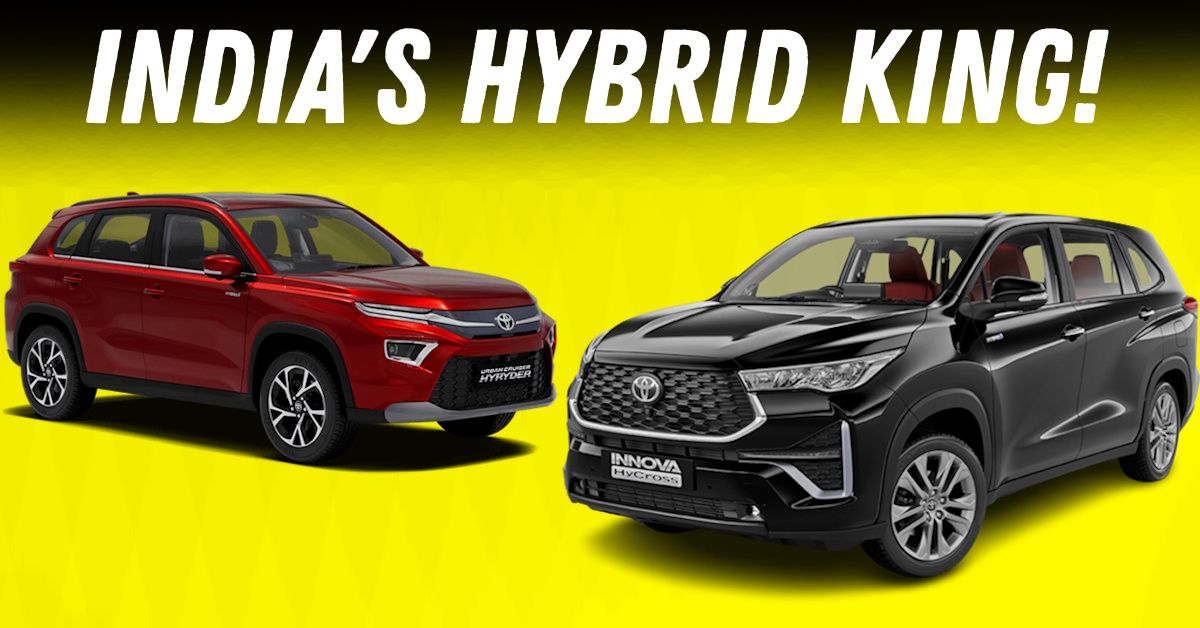8 Out Of 10 Strong Hybrid Cars Sold In India Are Toyotas


Even as EVs generate all the buzz, India’s automotive landscape is undergoing a quiet but impactful shift, with strong hybrids: vehicles that combine petrol engines with self-charging electric systems are gradually gaining popularity. Leading this transformation is Toyota Kirloskar Motor (TKM), which now commands a remarkable 80% share of India’s strong hybrid segment. This dominance stems from timely product launches, well-judged pricing, and Toyota’s longstanding reputation for reliable hybrid technology. And its partnership with Maruti Suzuki.
Between January and July 2024, Toyota clocked 50,000 hybrid car sales, largely fuelled by two models. The Urban Cruiser Hyryder accounted for 21,737 units during this period, with over half of its buyers opting for the hybrid variant. Priced between ₹11.3 lakh and ₹20.2 lakh, the Hyryder offers real-world mileage of 18 to 26.5 kmpl, making it an attractive option for budget-conscious customers.
Even more impressive has been the performance of the Innova Hycross, which sold 30,505 hybrid units in the same period. With mileage figures ranging from 16 to 19 kmpl and prices between ₹26.3 lakh and ₹31.3 lakh, it has found favour among large families and fleet buyers alike.
In contrast, the Maruti Suzuki Grand Vitara, a near-identical twin of the Hyryder, saw hybrids account for only 11% of its total sales. Industry watchers suggest this gap is due to Toyota’s stronger brand recall and perceived value in the premium segment.
Though on paper many hybrids boast similar mileage figures, real-world performance varies. The Hyryder, for instance, delivers up to 26.5 kmpl in typical conditions edging ahead of the Honda City Hybrid. While both the Hyryder and Grand Vitara share the same hybrid powertrain, Toyota’s version offers more refined transitions between electric and petrol modes, making it better suited to stop-start urban traffic. The Honda City Hybrid also performs well on efficiency, but its sedan format limits its appeal in an SUV-obsessed market.
Toyota’s hybrid pricing strategy covers a broad ₹10 lakh to ₹32 lakh spectrum. At one end, the base hybrid variant of the Hyryder is priced attractively at ₹18 lakh - undercutting the Honda City Hybrid. At the other end, the Hycross hybrid targets affluent buyers without clashing with Maruti’s more affordable offerings.
This pricing approach allows Toyota to serve a wide audience - from private buyers in metros to ride-hailing operators. In contrast, Honda and Hyundai currently lack such a wide portfolio in the strong hybrid space. While Hyundai’s Ioniq5 EV is due for a refresh, a mass-market hybrid from them is yet to emerge. Reports suggest that the next-gen Creta will be one of the first mass market Hyundais to go hybrid.
Toyota’s collaboration with Maruti Suzuki has proven strategic. While Maruti focuses on high-volume, mild-hybrid models, Toyota is carving out a niche among strong hybrid buyers in higher price brackets. The shared manufacturing facility in Karnataka enables scale economies, reducing per-unit costs by around 15%. This division of focus avoids internal competition, while also strengthening supply chains as localisation norms become stricter.
While Toyota enjoys a commanding lead today, competition is on the horizon. Maruti is preparing to launch affordable strong hybrids in its popular models like the Swift and Fronx. Hyundai-Kia, too, is investing heavily in localisation, with plans to manufacture hybrid systems in Tamil Nadu by 2026, potentially making their hybrids more price-competitive. Policy uncertainty remains a challenge as well. Hybrids currently attract a 43% GST slab - far higher than the 5% levied on pure EVs. If this imbalance isn’t corrected, it could affect long-term buyer sentiment. However, states such as Uttar Pradesh have exempted strong hybrids from registration charges [which add 10-12 percent to a cars on-road price].
Toyota’s lead isn’t accidental. It reflects the company’s nuanced understanding of the Indian buyer, who seeks both efficiency and reliability without sacrificing practicality. In a country still building EV infrastructure, strong hybrids serve as a pragmatic bridge between ICE and electric. With the market for hybrids projected to grow by 30% annually till 2030, Toyota’s early bet on this segment has placed it in pole position.
But the next few years will be crucial. If rivals can localise quickly and offer compelling alternatives at lower price points, Toyota’s 80% market share could be up for grabs. The hybrid space in India may be a one-horse race today, but the finish line is still far away.
Would you like a follow-up piece on how GST reforms or Maruti’s upcoming launches could change the hybrid market?